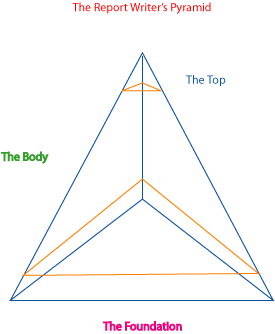
The pyramid is an organizing structure that is based on the work of Canadian technical writer Ken Ober, in his book Successful Business Reports (1982). It allows you to visualize the structure of a document in three dimensions, and to understand, architecturally, the role each part of the document plays.

This section gives an overview and perspective of the whole document. The busy reader will skim it and should be able to understand the document's purpose and contents. It shows the whole structure of the document in miniature; think of it as a preview to the document. It takes up 5% to 10% of the whole.
This part of the document is the "bricks and mortar"--it's the structure of the content. It gives details, facts, information of interest to close observers. It may follow a standardized form or template. It usually has a discernible order, such as
It takes up 80-90% of the document.
This section holds the whole document together. It provides a way of "getting out" by initiating further contact, announcing action, encouraging dialogue. Without it, the document is incomplete, and its purpose may "slip away into the sand" and be lost. A good foundation can be the difference between the success and failure of a communication. It takes up 5-10% of the document.
See how poor organization affects the impact your communication has on readers? Now look at some revised versions that take into account reader-based organization and a you-focused approach.